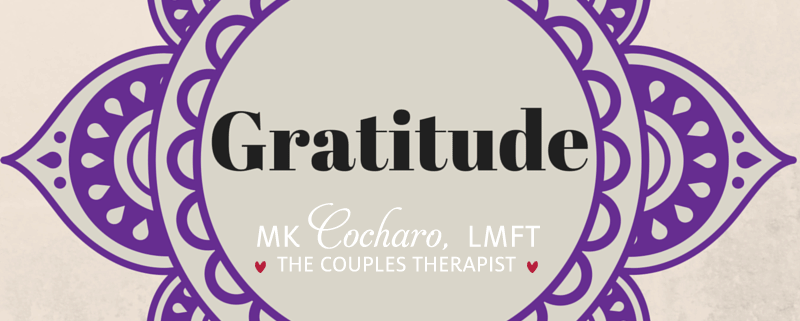Stop, Look and Enjoy this Holiday Season with Gratitude
“In daily life we must see that it is not happiness that makes us grateful, but gratefulness that makes us happy.” ~ David Steindl-Rast
The time between Halloween and New Year’s Day offers us the possibility of joy and connection to family and friends, as well as the possibility for stress, and feelings of being overwhelmed. What then are the practices we can engage in that will bring us more joy and less stress?
Let’s explore the relationship between Gratitude and Happiness.
In the research findings from the Reflective Happiness Project, Martin Seligman, PhD. found that after counting their blessings for one week, 92% of people felt happier and 94% of people who said they were depressed felt less depressed. In other studies, 90% of people found that expressing gratitude made them more joyful; 84% said it reduced stress and depression, and helped create optimism; and 78% said it gave them more energy.
It might also help to know that there are actually two types of Gratitude:
- Constructive Gratitude is defined as the kind of gratitude that is easy to come by for most us.
It’s easy to construct and see these blessings in plain view: a home, a job, a mate, friends, family, money in the bank.This is also the gratitude that is most easily taken for granted. It’s the gratitude we feel easy happiness from; it’s typically about things that naturally please us. Constructive gratitude is the ME-gratitude because it’s often “all about me” and what makes me feel good. That’s all fine, but it’s also important to have a bigger picture of gratitude, one that is unconditional of happy circumstances. - Reconstructive Gratitude is usually found only when something falls apart and needs to be reconstructed.
We have deep insights and healing around this type of gratitude, though it can be a painful route to achieve appreciation in this manner. Divorce, job loss, illness, death of a loved one, are the big reconstructive gratitude subjects. Smaller scale reconstructive gratitude revolves around such experiences as disagreements with a co-worker, anger at a spouse for not meeting your needs, frustration with your child, etc… Viewed through a “How Can I Grow Through This Experience?” framework, reconstructive gratitude is a powerful force in propelling us to reach out, connect, and give of ourselves to each other and the world. If we have been deeply affected through circumstances that have motivated us to count our blessings in the face of challenges, we often want to then ease suffering in others who are going through a similar experience. Reconstructive gratitude leads to deeper compassion and is what called WE-gratitude.
Considering these two types of gratitude practices, I am drawn to thinking about a certain pie chart also given to us by Dr. Seligman. The chart shows three areas that motivate happiness:
- About 50% is set by personality and temperament.
- Another 10% is determined by life’s circumstances
- The final 40% is intentional.
When I presented this chart at a recent workshop entitled, Creating Inner Peace, participants were surprised that circumstance only accounts for 10% of happiness. Most thought that our mate, job, home, financial status, etc. accounted for about 99%!!
I think that it is precisely this 10% slice of the pie (happiness caused by life’s circumstances) that we can easily focus on when practicing Constructive Gratitude. It comes in the form of “I’m grateful for my house, my job, my car, my kids, my health, my bank account etc.”. While this is a good start, it is important to remember that we’re only touching a small part of what ultimately can create our happiness.
As a therapist, I’ve been able to really see the difference between people who’s genetic set points are negative and those whose points are innately more positive. This is the old “glass half full/glass half empty” difference. For people who tend to see the world as “half full” gratitude comes easier. For the rest of us, a practice of Reconstructive Gratitude is essential.
Reconstructive gratitude is not automatic. It’s a discipline that needs to be practiced. This is the Intentional 40% of the pie chart. In asking the questions, “What’s the opportunity for growth in this experience?”, “What can I learn from this?” or even “What’s God/Universe/Spirit trying to teach me here?”, we can mine for the gold in each challenge.
Remember that gratitude is like a flashlight shining on what’s good in our lives, but we need to turn it on!
This holiday season, I invite you to keep a daily Gratitude Journal. Make two columns—one for Constructive Gratitude and one for Reconstructive Gratitude. Knowing that you’ll be writing in your journal each evening, will encourage you to look for the gratitude in everyday circumstances.
Wishing you a Happy, Grateful Holiday Season!














Leave a Reply
Want to join the discussion?Feel free to contribute!